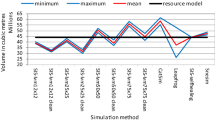Abstract
The aim of this paper is to present a fast method based on bootstrapping, for simulating recoverable reserves for input to financial Monte Carlo simulations. In mining, the three parameters defining recoverable reserves are the cutoff grade, z, the ore tonnage above cutoff, T, and the metal quantity above cutoff, Q. After introducing the concept of 3-dimensional QTz curves, the statistical technique called bootstrapping is reviewed and applied to a set of South African gold grades. As selective mining is carried out on blocks not points, these curves have to be calculated for blocks. The QTz curves obtained by bootstrapping are compared to those obtained by conditionally simulating the same deposit. The procedure has been extended to incorporate geologists' ideas of the likely size of the ore volume. Lastly, the recoverable reserves obtained by bootstrapping are compared with those obtained by traditional risk analysis (base case ± 10% or 20%).
Similar content being viewed by others
REFERENCES
Armstrong, M., and Berckmans, A., 1996, QTz curves for two skew distributions: Trans. Instn. Min. Metall., v. 105, p. A157–A162.
Berckmans, A., 1997, QTZ curves: A tool to calculate ore resources and assess the ore reserve risk: European Doctorate in Geostatistics, Centre de Géostatistique, School of Mines of Paris, 176 p.
Berckmans, A., and Armstrong, M., 1996, Visualising QTz curves for the lognormal distribution: APCOM XXVI Conference, Penn State University Park, Penn State, USA, September 16–20, 1996, p. 33–37.
Berckmans, A., and Armstrong, M. 1997, Geostatistics applied to the Monte Carlo analysis of mining projects, in Baafi, E. Y., and Schofield, N. A. (eds.), Geostatistics Wollongong' 96 (Vol. 2): Kluwer Academic Publishers, Dordrecht, Netherlands, p. 743–754.
Dowd, P. A., 1994, Risk assessment in reserve estimation and open-pit planning: Trans. Inst. Min. Metall., v. 103, p. A148–A154.
Dowd, P. A., 1995, Risk assessment in mineral projects: Analysis, perception and management: UK National Minerals Conference, University of Leeds, April 3–5, 1995.
Efron, B., 1979, Bootstrap methods: Another look at the jackknife: Annals of Statistics, v. 7, p. 1–26.
Efron, B., and Tibshirani, R. J., 1993, An introduction to the bootstrap: Chapman & Hall, New York, 436 p.
Gotway, C., and Rutherford, B., 1994, Stochastic simulation for imaging spatial uncertainty: Comparison and evaluation of available algorithms, in Armstrong, M., and Dowd, P. A., eds., Geostatistical simulations: Kluwer Academic Press, Dordrecht, Holland, p. 1–21.
Küncsch, H. R., 1989, The jacknife and the bootstrap for general stationary observations: Ann. Stat., v. 17, no. 3, p. 1217–1241.
Lajaunie, C., 1990, Intervalles de confiance pour la moyenne a champs fixe: Technical report N-20 ?90 ?G, Centre de Geostatistique, ENSMP, 58 p.
Matheron, G., 1976, A simple substitute for conditional expectation: Disjunctive kriging, in Proceedings of the First NATO Study Inst., Advanced geostatistics in the mining industry: D. Reidel Publishing Co., p. 221–236.
Matheron, G., 1983, The selectivity of the distributions and the second principle of geostatistics: Note N-800, Centre de Géostatistique, Fontainebleau, 13 p.
Rivoirard, J., 1994, Introduction to disjunctive kriging and non-linear geostatistics: Oxford University Press, 180 p.
Safai-Naraghi, K., and Marcotte, D., 1997, Bootstrapping variograms, in Baafi, E. Y., and Schofield, N. A., eds., Geostatistics Wollongong' 96: Kluwer Academic Press, Dordrecht, Holland, p. 188–199.
Solow, A. R., 1985, Bootstrapping correlated data: Math. Geology, v. 17, no. 7, p. 769–775.
Author information
Authors and Affiliations
Rights and permissions
About this article
Cite this article
Berckmans, A., Armstrong, M. Bootstrapping: A Fast Way to Simulate QTz Curves. Mathematical Geology 31, 471–485 (1999). https://doi.org/10.1023/A:1007546926089
Issue Date:
DOI: https://doi.org/10.1023/A:1007546926089




